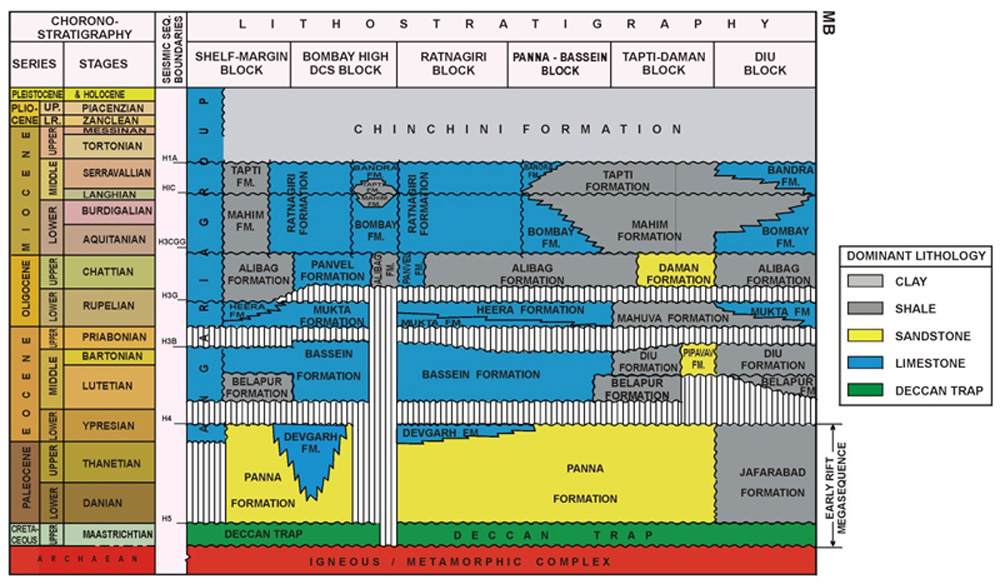Bassein Fm
Type Locality and Naming
The Paleogene limestone occurring between the seismic horizons H-4 and H-3G was named as the Bassein Formation by Basu et al. (1982). Later Guha et al. (1986) studied this formation in detail and concluded that Bassein Formation of Basu et al. (1982) straddles across a major unconformity and the facies and lithology of the limestones across this unconformity are different. Well BS – 1, (depth interval 1765 – 2070 m). [Original Publication: Basu, D.N., Banerjee, A and Tamhane, D.M. 1982. Facies distribution and petroleum geology of Bombay Offshore Basin, India. Journal Petroleum Geology, Volume 5, pp. 57-75.]. Reference wells: Well SB – 4 (depth interval 1725 -2152 m); Well D – 11 – 1 (depth interval 3034 – 3705 m); Well R – 2 – 1 (depth interval 909 – 1338 m); 427 m thickness in Well SB- 4; 671 m thickness in Well D-11-1; and 429 m thickness in Well D-4-1
[Figure: Lithostratigraphy in Mumbai Offshore blocks (from NDRDGH.gov.in; after Jitendra Misra, 2009)]
Lithology and Thickness
Limestone. The Bassein Formation is characterized by a monotonous, buff to light brown, highly porous wackstone in the upper part and hard packstone towards the base. Occasionally echinodermal wackstone constitute the middle part.
The formation is 305 m thick in the type section. Its thick varies drastically, from less than 100 m over the Paleohigh to more than 700 m in the western and southern parts of Bombay High-DCS block.
[Figure 1: Formations and their reference sections in Mumbai Offshore Basin (after Pandey and Dave, 1998)]
Relationships and Distribution
Lower contact
Unconformable with the Panna Fm. In the shelf margin block and Mahim graben, it overlies the shale of the Belapur Fm. Over Ratnagiri and DVS area, it unconformably overlies the Devgarh Fm.
Upper contact
A regional unconformity (H-3B sequence boundary) separates the Bassein Formation from the overlying Mukta Fm. Over most of the shelf area, base of 15-20 m thick high-gamma marker (clay) define its upper boundary.
Regional extent
GeoJSON
Fossils
In the Panna-Bassein area, the top part of the formation coincides with the top of Coskinolina-Fasciolites Assemblage Zone. In a few wells, typical Late Eocene forams, like Pellatispira sp., Nummulites fabiani etc., occur in the uppermost part of the Bassein Formation.
Age
Depositional setting
A wide range of environments like restricted platform (Shelf lagoon) with isolated shale in the Bassin area to open carbonate platform in Bombay High and Ratnagiri area, and finally deeper water carbonates over most of the self margin blocks.
Additional Information

